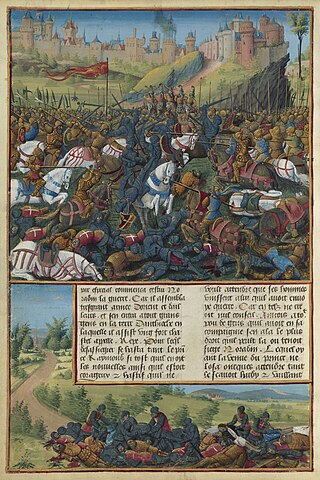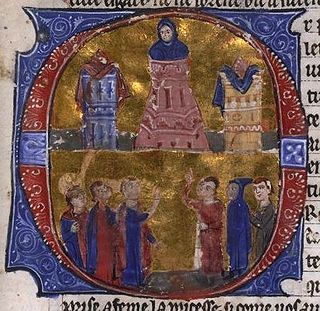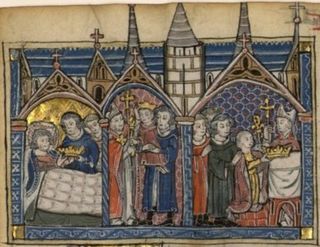
Aimery of Lusignan, erroneously referred to as Amalric or Amaury in earlier scholarship, was the first King of Cyprus, reigning from 1196 to his death. He also reigned as the King of Jerusalem from his marriage to Isabella I in 1197 to his death. He was a younger son of Hugh VIII of Lusignan, a nobleman in Poitou. After participating in a rebellion against Henry II of England in 1168, he went to the Holy Land and settled in the Kingdom of Jerusalem.

The 12th century is the period from 1101 to 1200 in accordance with the Julian calendar. In the history of European culture, this period is considered part of the High Middle Ages and overlaps with what is often called the "'Golden Age' of the Cistercians". The Golden Age of Islam experienced significant development, particularly in Islamic Spain.

Year 1179 (MCLXXIX) was a common year starting on Monday of the Julian calendar.

Year 1187 (MCLXXXVII) was a common year starting on Thursday of the Julian calendar.
The 1180s was a decade of the Julian Calendar which began on January 1, 1180, and ended on December 31, 1189.

Year 1176 (MCLXXVI) was a leap year starting on Thursday of the Julian calendar, the 1176th year of the Common Era (CE) and Anno Domini (AD) designations, the 176th year of the 2nd millennium, the 76th year of 12th century, and the 7th year of the 1170s decade.

Year 1191 (MCXCI) was a common year starting on Tuesday of the Julian calendar.

Year 1182 (MCLXXXII) was a common year starting on Friday of the Julian calendar.

The First Crusade (1096–1099) was the first of a series of religious wars, or Crusades, initiated, supported and at times directed by the Latin Church in the medieval period. The objective was the recovery of the Holy Land from Islamic rule. While Jerusalem had been under Muslim rule for hundreds of years, by the 11th century the Seljuk takeover of the region threatened local Christian populations, pilgrimages from the West, and the Byzantine Empire itself. The earliest initiative for the First Crusade began in 1095 when Byzantine emperor Alexios I Komnenos requested military support from the Council of Piacenza in the empire's conflict with the Seljuk-led Turks. This was followed later in the year by the Council of Clermont, during which Pope Urban II supported the Byzantine request for military assistance and also urged faithful Christians to undertake an armed pilgrimage to Jerusalem.

The Second Crusade (1147–1150) was the second major crusade launched from Europe. The Second Crusade was started in response to the fall of the County of Edessa in 1144 to the forces of Zengi. The county had been founded during the First Crusade (1096–1099) by King Baldwin I of Jerusalem in 1098. While it was the first Crusader state to be founded, it was also the first to fall.

The Third Crusade (1189–1192) was an attempt led by three European monarchs of Western Christianity to reconquer the Holy Land following the capture of Jerusalem by the Ayyubid sultan Saladin in 1187. For this reason, the Third Crusade is also known as the Kings' Crusade.

Baldwin I was the first count of Edessa from 1098 to 1100 and king of Jerusalem from 1100 to his death in 1118. He was the youngest son of Eustace II, Count of Boulogne, and Ida of Lorraine and married a Norman noblewoman, Godehilde of Tosny. He received the County of Verdun in 1096, but he soon joined the crusader army of his brother Godfrey of Bouillon and became one of the most successful commanders of the First Crusade.

Baldwin IV (1161–1185), called the Leper King, was the king of Jerusalem, from 1174 until his death in 1185. He was admired by his contemporaries and later historians for his willpower and dedication to the Latin Kingdom in the face of debilitating leprosy. Choosing competent advisers, Baldwin ruled a thriving crusader state and succeeded in protecting it from the Muslim ruler Saladin.

Raynald of Châtillon, also known as Reynald, Reginald, or Renaud, was a knight of French origin who became Prince of Antioch from 1153 to 1160 or 1161 and Lord of Oultrejordain from 1175 until his death. The second son of a French noble family, he joined the Second Crusade in 1147, and settled in the Kingdom of Jerusalem as a mercenary. Six years later, he married Constance, Princess of Antioch, in spite of her subjects' opposition.

The Crusader states, or Outremer, were four Catholic polities that existed in the Levant from 1098 to 1291. Following the principles of feudalism, the foundation for these polities was laid by the First Crusade, which was proclaimed by the Latin Church in 1095 in order to reclaim the Holy Land after it was lost to the 7th-century Muslim conquest. Situated on the Eastern Mediterranean, the four states were, in order from north to south: the County of Edessa (1098–1150), the Principality of Antioch (1098–1268), the County of Tripoli (1102–1289), and the Kingdom of Jerusalem (1099–1291). The three northern states covered an area in what is now southeastern Turkey, northwestern Syria, and northern Lebanon; and the Kingdom of Jerusalem, the southernmost and most prominent state, covered an area in what is now Israel, the State of Palestine, southern Lebanon, and western Jordan. The description "Crusader states" can be misleading, as from 1130 onwards, very few people among the Franks were Crusaders. Medieval and modern writers use the term "Outremer" as a synonym, derived from the French word for overseas.

Raymond III was count of Tripoli from 1152 to 1187. He was a minor when Nizari Assassins murdered his father, Raymond II of Tripoli. Baldwin III of Jerusalem, who was staying in Tripoli, made Raymond's mother, Hodierna of Jerusalem, regent. Raymond spent the following years at the royal court in Jerusalem. He reached the age of majority in 1155, after which he participated in a series of military campaigns against Nur ad-Din, the Zengid ruler of Damascus. In 1161 he hired pirates to pillage the Byzantine coastline and islands to take vengeance on Byzantine emperor Manuel I Komnenos, who had refused to marry his sister Melisende. He was captured in the Battle of Harim by Nur ad-Din's troops on 10 August 1164, and imprisoned in Aleppo for almost ten years. During his captivity, Amalric I of Jerusalem administered the county of Tripoli on his behalf.

The Crusade of 1101 was a minor crusade of three separate movements, organized in 1100 and 1101 in the successful aftermath of the First Crusade. It is also called the Crusade of the Faint-Hearted due to the number of participants who joined this crusade after having turned back from the First Crusade.

The siege of Jerusalem lasted from 20 September to 2 October 1187, when Balian of Ibelin surrendered the city to Saladin. Earlier that summer, Saladin had defeated the kingdom's army and conquered several cities. Balian was charged with organizing a defense. The city was full of refugees but had few soldiers. Despite this fact the defenders managed to repulse several attempts by Saladin's army to take the city by storm. Balian bargained with Saladin to buy safe passage for many, and the city was peacefully surrendered with limited bloodshed. Though Jerusalem fell, it was not the end of the Kingdom of Jerusalem, as the capital shifted first to Tyre and later to Acre after the Third Crusade. Latin Christians responded in 1189 by launching the Third Crusade led by Richard the Lionheart, Philip Augustus, and Frederick Barbarossa separately. In Jerusalem, Saladin restored Muslim holy sites and generally showed tolerance towards Christians; he allowed Orthodox and Eastern Christian pilgrims to visit the holy sites freely—though Frankish pilgrims were required to pay a fee for entry. The control of Christian affairs in the city was handed over to the patriarch of Constantinople.

The Crusades were a series of religious wars initiated, supported, and sometimes directed by the Christian Latin Church in the medieval period. The best known of these military expeditions are those to the Holy Land in the period between 1095 and 1291 that were intended to conquer Jerusalem and its surrounding area from Muslim rule. Beginning with the First Crusade, which resulted in the conquest of Jerusalem in 1099, dozens of military campaigns were organised, providing a focal point of European history for centuries. Crusading declined rapidly after the 15th century.

Jerusalem in the Middle Ages was a major Byzantine metropolis from the 4th century CE before the advent on the early Islamic period in the 7th century saw it become the regional capital of Jund Filastin under successive caliphates. In the later Islamic period it went on to experience a period of more contested ownership, war and decline. Muslim rule was interrupted for a period of about 200 years by the Crusades and the establishment of the Christian Kingdom of Jerusalem. At the tail end of the Medieval period, the city was ceded to the Ottomans in 1517, who maintained control of it until the British took it in 1917.


















